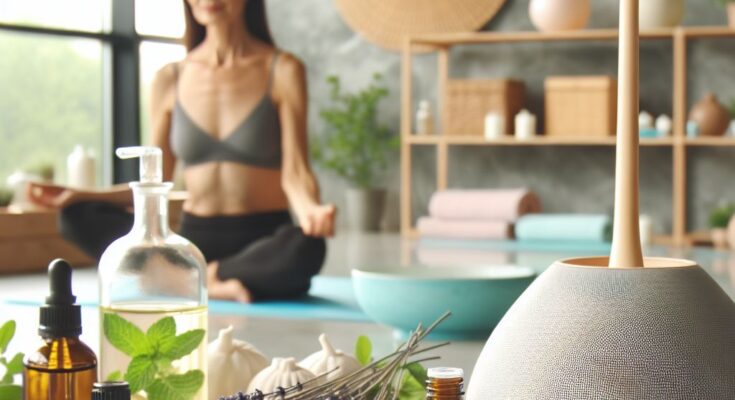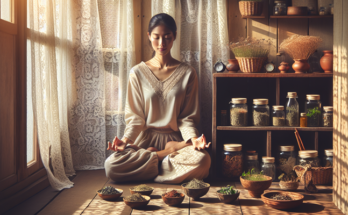Discover the natural relief of aromatherapy for menopause. Harnessing the power of essential oils like lavender and clary sage, it offers a gentle approach to hormone balance and symptom management. Learn the best oils and methods to complement your holistic well-being journey.
Key Takeaways
- Aromatherapy can be a natural, effective way to manage menopause symptoms.
- Essential oils like lavender and clary sage may help balance hormones and alleviate menopause-related issues.
- It’s essential to choose the right essential oils and application methods for the best results.
- While aromatherapy can offer relief, it should be used as a complement to other treatments, not a replacement.
- Safety and quality are paramount—use high-quality oils and proper dilution techniques.
In a Nutshell: What is Aromatherapy?
Aromatherapy is a natural healing practice that uses the scent of essential oils to promote health and well-being. These essential oils are extracted from plants, flowers, fruits, and other natural sources.
When you use aromatherapy, you inhale the aroma of these oils, which can have various effects on your body and mind. Different essential oils have different properties and scents, and each one can offer unique benefits.
For example, some essential oils are known for their calming and relaxing effects, while others are energizing or uplifting. Some oils can help reduce stress and anxiety, while others can soothe headaches or improve concentration.
Aromatherapy can be used in many ways. You can add a few drops of essential oil to a diffuser or humidifier to fill the air with its scent. You can also mix essential oils with a carrier oil, such as coconut or almond oil, and apply them to your skin through massage.
Many people also use aromatherapy during baths by adding a few drops of essential oil to their bathwater. Some even use essential oils in homemade cleaning products or as natural insect repellents.
Overall, aromatherapy is a gentle and natural way to support your health and well-being. It’s important to choose high-quality essential oils and use them safely, following guidelines for dilution and application. If you’re pregnant, have certain medical conditions, or are taking medications, it’s a good idea to consult with a healthcare professional before using aromatherapy.
Menopause Symptoms Soothed by Aromatherapy
Menopause can be a roller coaster of hormones, leading to a host of symptoms like hot flashes, mood swings, and sleep disturbances. Aromatherapy steps in as a gentle giant in this tumultuous time, offering a natural way to ease these discomforts. With the right essential oils, you can create an oasis of calm, helping your body to navigate the changes it’s going through.
The Role of Essential Oils in Menopause Relief
Essential oils are powerful allies in the quest for menopause relief. They contain the very essence of plants, including their healing properties. When used correctly, these oils can have a profound impact on our hormonal balance and overall well-being. They work through the sense of smell, directly impacting the brain’s emotional center, and when applied to the skin, they penetrate deeply to deliver their benefits.
Choosing the Right Aromatherapy Approach
But how do you choose the right essential oils? It’s all about understanding your symptoms and how different oils can address them. For example, lavender is known for its calming properties—perfect for those sleepless nights or when anxiety strikes. On the other hand, peppermint can cool you down during a hot flash. It’s about personalizing your aromatherapy journey to fit your unique needs.
Understanding Menopause and Its Challenges
Menopause is not just a single event; it’s a transition that can span several years. It’s marked by the end of menstrual cycles and a significant shift in hormone levels. These changes can lead to a variety of symptoms that vary in intensity from woman to woman. That’s why understanding menopause is the first step in managing its challenges effectively.
Hormonal Changes During Menopause
As you enter menopause, your body reduces the production of estrogen and progesterone, two hormones that have regulated your reproductive cycle for years. This hormonal upheaval can affect nearly every part of your body, from your bones to your brain, hence the wide range of symptoms that can occur.
Let’s break it down:
- Estrogen: A drop in this hormone can lead to hot flashes, night sweats, and vaginal dryness.
- Progesterone: Changes in its levels can cause sleep issues and mood swings.
These hormonal fluctuations are a natural part of aging, but that doesn’t mean you have to suffer through them without help.
Common Symptoms Addressed Through Aromatherapy
Aromatherapy can be a beacon of relief for many common menopause symptoms. Here’s how:
- Hot flashes: Peppermint oil can provide a cooling effect.
- Sleep disturbances: Lavender oil is renowned for its ability to improve sleep quality.
- Mood swings: Citrus oils, like bergamot, can uplift your mood.
- Anxiety: Rose oil can help soothe your nerves.
By targeting these symptoms, aromatherapy offers a tailored approach to menopause management.
Evidence Supporting Aromatherapy for Hormonal Balance
Research into aromatherapy shows it’s not just wishful thinking; there’s science backing its benefits for hormonal balance. Certain essential oils have properties that can mimic hormones or encourage the body to produce its own hormones more effectively. This can be particularly helpful during menopause, when the body’s natural hormone production is changing.
Top Essential Oils for Menopause Symptom Relief
Now, let’s dive into the essential oils that stand out in the relief of menopause symptoms. Each oil has unique properties that target different aspects of menopause, providing a natural way to find balance and comfort during this phase of life.
Lavender for Sleep Disturbances and Anxiety
Lavender is the go-to oil for relaxation and sleep. Its gentle, soothing scent can help quiet the mind and ease anxiety, which is crucial when you’re dealing with menopause-related sleep disturbances.
But how exactly does lavender help? It’s believed to increase the production of GABA, a calming neurotransmitter in the brain, which helps to turn down the volume on racing thoughts and allows for a more restful sleep.
Example: A study in the Journal of Alternative and Complementary Medicine found that inhalation of lavender essential oil improved sleep quality among menopausal women.
Most importantly, it’s easy to incorporate lavender into your nightly routine. A few drops on your pillow or in a diffuser can pave the way for a peaceful slumber.
Peppermint for Hot Flashes and Headaches
Peppermint oil is like a cool breeze on a sweltering day. It’s refreshing and can provide quick relief for hot flashes, which are arguably the most notorious symptom of menopause.
The menthol in peppermint creates a cooling sensation, making it ideal for those sudden rushes of heat. It’s also excellent for tension headaches that can occur due to hormonal changes.
Clary Sage for Hormonal Equilibrium
Clary sage is often hailed as one of the most effective oils for hormonal balance. It’s thought to have an estrogen-like effect on the body, which can be beneficial when your own estrogen levels are waning.
Clary sage can also reduce cortisol levels, the stress hormone, promoting a sense of calm and helping to alleviate mood swings. When you’re feeling out of sorts, a whiff of clary sage might just be the grounding force you need.
And there’s evidence to back this up. A study published in Phytotherapy Research indicated that clary sage oil could reduce cortisol levels and improve thyroid hormone levels.
Rose Oil for Emotional Well-being and Libido
Rose oil isn’t just a symbol of romance; it can also be a powerful tool for emotional well-being during menopause. Its comforting scent can alleviate depression and improve sexual desire, which can sometimes take a hit during this time.
Geranium for Mood Swings and Irregularities
Geranium oil is another heavyweight in the world of menopause relief. It’s known for its hormone-balancing effects and can help regulate menstrual cycles and reduce mood swings. Its sweet, floral scent is also uplifting, making it perfect for those days when you need a little boost.
Incorporating Aromatherapy into Your Daily Routine

Consistency is key when it comes to aromatherapy. To reap the full benefits, make it a part of your daily routine. This could mean starting your day with an energizing scent like citrus or winding down with a calming oil like lavender.
Remember, aromatherapy is versatile. You can use it through direct inhalation, diffusers, or topical application with a carrier oil. Experiment to find what works best for you and your lifestyle.
Creating an Aromatherapy Ritual at Home
Creating a ritual around aromatherapy can provide structure and enhance its effectiveness. For example, using a diffuser with a relaxing blend an hour before bedtime signals to your body that it’s time to wind down, promoting better sleep hygiene.
Stress-Relief Techniques with Essential Oils
Besides that, aromatherapy can be a part of stress-relief techniques like massage or meditation. Adding a few drops of oil to your massage lotion can deepen the relaxation effect, and diffusing oils during meditation can help focus your mind and ease anxiety.
Remember, managing stress is crucial during menopause, as stress can exacerbate symptoms like hot flashes and mood swings.
Tips for Safe and Effective Aromatherapy Practice
While aromatherapy is natural, it’s not without its precautions. To ensure safety and effectiveness, it’s crucial to understand the best practices for using essential oils.
Understanding Dilution and Application Methods
Essential oils are potent, and most should be diluted with a carrier oil before applying to the skin to prevent irritation. A general guideline is to use about 6 drops of essential oil per ounce of carrier oil.
Also, consider the method of application. For hot flashes, a cool compress with a few drops of peppermint oil can be refreshing, while a warm bath with lavender can soothe sore muscles and calm the mind.
With these insights and practical tips, you can harness the power of aromatherapy to manage menopause symptoms more naturally and effectively. Remember, you have the power to create a balanced and comfortable menopause experience.
Tips for Safe and Effective Aromatherapy Practice
As you embark on your aromatherapy journey, remember that while essential oils are natural, they are also highly concentrated and must be used with care. To ensure safety and maximize benefits, follow these tips for safe and effective aromatherapy practice.
Understanding the correct dilution ratios, choosing high-quality oils, and knowing the best application methods will help you avoid any adverse reactions and get the most out of your aromatherapy experience.
Understanding Dilution and Application Methods
Essential oils should almost always be diluted with a carrier oil before being applied to the skin. The typical dilution ratio is 1-2% for adults, which translates to about 6-12 drops of essential oil per ounce of carrier oil. This helps to prevent skin irritation and systemic toxicity. For aromatic use, a diffuser can disperse oils into the air safely, and inhalers or steam inhalations are also effective methods for targeted relief.
Recognizing High-Quality Essential Oils
Not all essential oils are created equal. It’s vital to use high-quality, pure essential oils for therapeutic use. Look for oils that are labeled as “100% pure essential oil” and check for a company’s reputation, reviews, and testing practices. Oils that have a “therapeutic grade” label, while not regulated, often indicate a company’s commitment to quality.
Empowered Choices: Selecting the Best Aromatherapy Products
With a myriad of aromatherapy products available, it’s important to make empowered choices. Opt for products from reputable brands that provide detailed information about the oil’s botanical name, purity, and origin. This transparency is a good indicator of quality and ensures that you’re getting genuine, effective products.
Comparing Diffusers and Other Aromatherapy Tools

When it comes to diffusers, there are several types to choose from: ultrasonic, nebulizing, heat, and evaporative. Each has its own method of dispersing oils into the air, and your choice will depend on your preferences and needs. Ultrasonic diffusers are popular for their ability to double as a humidifier, while nebulizing diffusers are known for their potency and purity of scent.
Besides diffusers, consider other tools like rollerball applicators for targeted topical application, inhalers for on-the-go aromatherapy, and even jewelry designed to hold and slowly release essential oils throughout the day.
The Importance of Sourcing and Sustainability
Where and how essential oils are sourced can impact their quality and the environment. Look for companies that source oils sustainably and ethically. Responsible sourcing ensures the long-term viability of plant species and supports the communities involved in the harvesting and distillation processes.
Furthermore, choosing organic essential oils can help avoid exposure to pesticides and other chemicals that could be present in non-organic oils. This is not only better for your health but also supports sustainable farming practices.
Frequently Asked Questions
When it comes to using aromatherapy for menopause, there are often many questions about its efficacy, safety, and methods. Here are some answers to frequently asked questions to help you navigate your aromatherapy journey with confidence.
How Quickly Can I Expect Relief Using Aromatherapy?
The onset of relief with aromatherapy can vary depending on the individual and the symptom being treated. Some may experience immediate relief, especially for acute symptoms like hot flashes or anxiety, while others may notice gradual improvements over time with consistent use.
It’s important to have realistic expectations and understand that aromatherapy is often most effective when used as part of a comprehensive approach to managing menopause symptoms.
- Hot flashes: Immediate cooling effect with peppermint oil.
- Sleep disturbances: Gradual improvement over weeks with nightly lavender use.
- Mood swings: Varied response; some may feel uplifted instantly, while others may need consistent use.
Can Aromatherapy Completely Replace Other Menopause Treatments?
While aromatherapy can be a powerful tool in managing menopause symptoms, it should not be seen as a complete replacement for other treatments. It’s best used in conjunction with lifestyle changes, dietary adjustments, and, when necessary, medical treatments prescribed by your healthcare provider.
Are There Any Risks Associated with Aromatherapy?
When used correctly, aromatherapy is generally safe for most people. However, there are potential risks, such as allergic reactions, skin irritation, or interactions with medications. It’s important to do a patch test before using a new oil topically and to consult with a healthcare professional if you’re pregnant, nursing, or have underlying health conditions.
How Do I Know Which Essential Oils Are Right for My Symptoms?
Choosing the right essential oils for your symptoms involves understanding their properties and how they interact with the body. Research, as well as trial and error, can help you determine which oils work best for you. Start with oils known to address specific menopause symptoms and adjust based on your personal experience and preferences.
For example:
Lavender for sleep and anxiety, peppermint for hot flashes, and clary sage for hormonal balance.
Can Aromatherapy Be Combined with Other Natural Remedies for Menopause?
Absolutely! Aromatherapy can be combined with other natural remedies for a holistic approach to menopause management. For instance, pairing aromatherapy with herbal supplements, yoga, or acupuncture can enhance overall well-being and symptom relief.
Remember to consult with a healthcare professional before combining treatments to ensure they complement each other safely and effectively.



